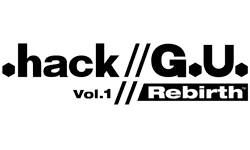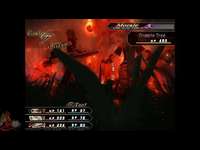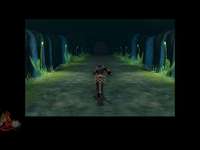|
|

|
BATTLE SYSTEM
|

|
INTERACTION
|

|
ORIGINALITY
|

|
STORY
|

|
MUSIC & SOUND
|

|
VISUALS
|

|
CHALLENGE
|
Easy/Unbalanced
|
COMPLETION TIME
|
25-40 Hours
|
|
OVERALL
3.0/5
|
Rating definitions
|
|
|
It's been several years since the last .hack subseries came to an end, but now it's time for the series to reawaken with its next series of installments. In .hack//G.U. Vol. 1: Rebirth, the first in the G.U. subseries, players take control of Haseo, the Terror of Death, as he chases after the legendary PK, Tri-Edge. As with the previous subseries, story remains a major emphasis. Sadly, dungeons remain fairly dull, though they are shorter and have slightly more variety this time around.
Rather than being open as in MMORPGs or the previous .hack titles, battles are now closed off so that it isn't possible for either party to escape without using a special item. Players attack enemies in real-time hack and slash, while guarding against attacks and using the occasional skill or spell. To mix things up, enemies will occasionally flash after being hit by a combo of a certain length. At this point, skills change into Rengenki attacks, which are essentially the same as the original skills except they deal more damage, grant bonus experience points, and raise the party's morale. Morale can be raised by performing actions that party members like as well, and once the morale gauge is full, it is possible to use an Awakening. There are two types of these, and they either grant the party a temporary boost in speed and attack power or allow unlimited spells to be used at no cost for the duration of the Awakening. These additions to the battle system are welcome, as they liven things up considerably, especially in PvP areas, but the changes to the battle system are not all good.
 Oh! He of fair eyes! Attack with the burning soul of passion!
Oh! He of fair eyes! Attack with the burning soul of passion!
|
|
Level has become far more important than in previous .hack titles, or pretty much any other game for that matter. Allies or enemies that are more than a few levels above their target gain tremendous attack bonuses. This makes it easy to crush lower level enemies in a single blow, but it also means that it is very cumbersome to train low level party members in high level dungeons. Because of this imbalance, most otherwise difficult bosses can be defeated in a single blow, and the game can be made very easy in general, should players take the time to level up a bit. Skill is no longer as much of a factor as it once was, and that drains the fun out of battles where there is a reasonably sized level gap. Fortunately, players can see an area's data before entering, so this can generally be avoided.
The input screen for the area words has been made a bit more user-friendly this time around, and few other parts of the interface have been tweaked as well. For example, shortcut buttons have been added for skills. Unfortunately, the controls could use a little more work, especially where the skill trigger is concerned, but the interface is decent overall. The localization is also pretty good, with just a few typos here and there. It seems that the Japanese language track is no longer included this time around, however.
As with its predecessors, .hack//G.U. Vol. 1: Rebirth places a great emphasis on its story. This particular volume succeeds in having a relatively self-contained story while building upon the story established by previous incarnations and setting up the rest of the G.U. subseries. For some reason, the anime prequel to .hack//G.U., .hack//Roots, has not been released in North America at this point, but it's still possible to pick up most of the key points by playing .hack//G.U. itself.
 Too bad dungeons are still quite bland.
Too bad dungeons are still quite bland.
|
|
Though there is a bit more time spent on the story this time around, leveling up in order to avoid the imbalance caused by a gap in levels adds a lot of padding to the overall playtime. Fortunately, this is somewhat made up for by reducing the number of mandatory dungeons that have minimal significance to the storyline, and the time-consuming virus core hunting has also been thankfully done away with. In the end, .hack//G.U. Vol. 1: Rebirth clocks in between twenty-five and forty hours, depending on how much risk players take when leveling up and how many of the more lengthy sidequests they complete.
Perhaps the largest of the improvements that .hack//G.U. has received is in its visuals. Characters are more detailed, towns are larger and more detailed, and even dungeons look better. The myriad of new facial expressions, in particular, stand out.
Unfortunately, the music has not received such an upgrade. Actually, due to the fact that each type of dungeon has its own music and shares the same battle theme, most background tracks have actually become more repetitive than before. Thankfully, this is largely balanced out by some of the more impressive tracks that appear in Lost Grounds and cutscenes.
.hack//G.U. Vol. 1: Rebirth has made a few improvements over the previous games in the series. Unfortunately, dungeons are still rather dull for the most part, and many of the improvements to the battle system have also been accompanied by problematic additions such as the increased importance of level. Though gameplay may be dull at times, players looking for a good story should definitely give .hack//G.U. Vol. 1: Rebirth a look.
Review Archives
|









